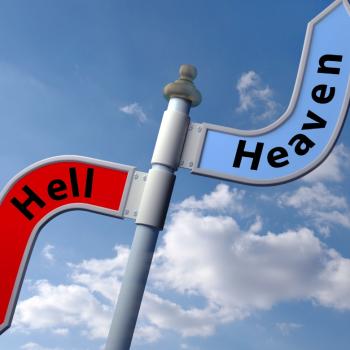TODAY IN GOD:
RELIGION NEWS BITES FOR YOUR SNACKING PLEASURE
____________________________________________________________________________________
‘Bong Hits 4 Jesus’ case limits student rights
WASHINGTON — The Supreme Court ruled against a former high school student Monday in the “Bong Hit 4 Jesus” banner case — a split decision that limits students’ free speech rights.
Joseph Frederick was 18 when he unveiled the 14-foot paper sign on a public sidewalk outside his Juneau, Alaska, high school in 2002.
Principal Deborah Morse confiscated it and suspended Frederick. He sued, taking his case all the way to the nation’s highest court.
The justices ruled 6-3 that Frederick’s free speech rights were not violated by his suspension over what the majority’s written opinion called a “sophomoric” banner.
“It was reasonable for (the principal) to conclude that the banner promoted illegal drug use– and that failing to act would send a powerful message to the students in her charge,” Chief Justice John Roberts wrote for the court’s majority.
Roberts added that while the court has limited student free speech rights in the past, young people do not give up all their First Amendment rights when they enter a school.
Roberts was supported by Justices Antonin Scalia, Anthony Kennedy, Clarence Thomas, Stephen Breyer, and Samuel Alito. Breyer noted separately he would give Morse qualified immunity from the lawsuit, but did not sign onto the majority’s broader free speech limits on students.
In dissent, Justice John Paul Stevens said, “This case began with a silly nonsensical banner, (and) ends with the court inventing out of whole cloth a special First Amendment rule permitting the censorship of any student speech that mentions drugs, so long as someone could perceive that speech to contain a latent pro-drug message.”
He was backed by Justices David Souter and Ruth Bader Ginsburg.
At issue was the discretion schools should be allowed to limit messages that appear to advocate illegal drug use. “Bong,” as noted in the appeal filed with the justices, “is a slang term for drug paraphernalia.”
The incident occurred in January 2002 just outside school grounds when the Olympic torch relay was moving through the Alaska capital on its way to the Salt Lake City, Utah, Winter Games.
FOR THE FULL STORY (CNN) CLCIK HERE
Seeking Answers With Field Trips in Faith:
Bosnian Hill Is Among World’s Sites Drawing Ever More Pilgrims
MEDJUGORJE, Bosnia — Nora McNulty, a Scottish grandmother, began climbing the hill at 5:50 a.m., having traveled 1,300 miles in search of something hard to find at home.
“Everybody is looking for peace, a calmness,” she said. “Here I can take my mind off everyday living.”
Long before farmers began tending their vineyards, at an hour when chatty crickets hiding among the wild pomegranate and fig trees made the only sound, McNulty, 63, started up the slope with 50 other pilgrims.
People have been coming to this rocky slope since June 24, 1981, when six children said the Virgin Mary appeared to them here. The crowds have grown so rapidly that an estimated 1 million people will visit this year, part of a global surge in spiritual travel.
According to travel agencies, religious Internet sites and analysts who study trends in spirituality, more people of just about every faith are visiting places with religious significance. Ten times more people are coming to Medjugorje now than a decade ago, and last year a record 6 million people visited the Western Wall, also known as the Wailing Wall, in Jerusalem. Saudi Arabia said 2.1 million people went to Mecca last December, 300,000 more than in 2000. An estimated 70 million Hindus went to the Ganges River in January and February for spiritual cleansing.
Todd M. Johnson, director of the Center for the Study of Global Christianity at Gordon-Conwell Theological Seminary in Massachusetts, said 7 percent of the world’s Christians — about 150 million people — are “on the move as pilgrims” each year.
“Perhaps the most important reason,” he said, “is that people are increasingly interested in experiencing their faith through more than just reading or singing.”
Growing numbers of religious travelers are also spending considerable time and money going to lesser-known spots, such as Santiago de Compostela in northeast Spain, where the apostle James is believed to be buried, and Czestochowa in Poland, where the apostle Luke is said to have painted the revered Black Madonna icon.
The Internet has allowed millions of people to learn about places they otherwise might never have heard of, and for many, cheaper airfare has made it easier to get there. Millions of people, including McNulty and others visiting this Balkan village, travel not as tourists but as pilgrims, seeking a chance to confirm, deepen or reflect upon their faith.
“Some people come expecting a miracle, but I’ve just come for peace, to feel free from worry and this horrible feeling that the world is ugly,” said McNulty, finding her footing on the rocky path with a walking stick in one hand and rosary beads in the other.
FOR THE FULL STORY (WASHINGTON POST) CLICK HERE
DEVIL DETOX:
Behind the scenes with the Vatican’s exorcists
The Devil doesn’t like Latin.
That is one of the first things I learnt from Father Gabriele Amorth, long known as Rome’s chief exorcist, even though that has never exactly been his formal title. Perhaps Rome’s chattiest exorcist is the more apt title. Now past the age of 80, Amorth has dedicated the last decades of his life to regaining for exorcism a measure of respectability.
Despite his advancing age, he continues to perform the rite several times a week at his office in Rome. Scores of people seek him out. He prefers to use Latin when he conducts exorcisms, he says, because it is most effective in challenging the Devil.
A little over a decade ago, Amorth founded the International Association of Exorcists, which holds a secret exorcists’ convention in Italy every two years. He is the group’s president emeritus. On alternate years, the national association of exorcists meets, also with Amorth in attendance.
Father Amorth has had a hand in recruiting, training, or inspiring many of today’s exorcists. In Italy the number of exorcists has, remarkably, grown tenfold in the last decade, by Amorth’s count. As he slows his pace ever so slightly – old age and the rigours of a strenuous vocation catching up to him – he has overseen a new generation of exorcists and helped to fuel a global renaissance of the ritual. Devil detox these days is something of a growth industry: in a world awash in catastrophe and unspeakable suffering, many people feel increasingly compelled to see evil in concrete and personified – not to mention simplified – forms, and to find a way to banish the bad.
FOR THE FULL STORY (an extract from Tracy Wilkinson’s book, The Vatican’s Exorcists, in UK TIMES ONLINE) CLICK HERE
Militant Students Capture Masseuses to Make a Point
ISLAMABAD, Pakistan — Dressed from head to toe in an all-enveloping black burka, Umm-e-Okasha joined a pack of students from her militant Islamic school on Friday night, and at midnight they drove to a massage parlor here in the Pakistani capital and rang the bell.
“There were about 25 Chinese women, dressed only in underpants and bras,” recalled Ms. Okasha, 24, a muscular high-school badminton champion who had shed her black garb for soft mauves, her face uncovered, during an interview inside the women-only confines of the school. “They scattered, but we managed to grab five.”
The vigilantes, including students from an affiliated school for men, shoved the skimpily clad Chinese masseuses into a car, gave them shawls for modesty and hauled them back to the school as hostages, she said.
Under pressure from Pakistan’s government, concerned about maintaining its friendly relations with China, the school released the Chinese masseuses on Saturday afternoon, less than 24 hours later.
The episode was just the latest brazen escapade in a campaign by Jamia Hafsa, the women’s boarding school, and its sprawling separate male counterpart, Jamia Faridia, to embarrass the government of Pakistan’s president, Gen. Pervez Musharraf, who is considered a close ally by the United States in the fight against terrorism.
FOR THE FULL STORY (NEW YORK TIMES) CLICK HERE
Parish flock to include geese
All Catholic priests are supposed to tend their flocks, but few take the job as literally as Rev. John Jamnicky.
“I don’t think any other parishes have this,” said Jamnicky, 61, still clad in a black suit and Roman collar as he lugged a pail of water to 50 chickens and eight geese he’s raising at St. Raphael the Archangel in far north suburban Antioch. “This isn’t your typical church.”
Technically, St. Raphael isn’t yet a church at all. But by the end of summer, the archdiocese of Chicago’s first new parish in eight years will operate in a highly unusual venue: a barn.
“My poor secretary, he didn’t realize what he was getting himself into,” Jamnicky said with a chuckle as he poured water for a group of boisterous chicks. “He’s going to have to help me out with this stuff.”
Until the funds can be raised to build St. Raphael’s permanent worship center on 40 acres along U.S. Highway 45, Jamnicky expects to spend five or six years ministering from a century-old farm the archdiocese is leasing from Antioch’s Pedersen family, which offered use of the site.
“We’re really excited about it,” said Linda Pedersen, who has been promised by Jamnicky that she and her husband, Dean, who grew up on the farm, will be the parish’s first official members. “Our grandson is also going to be the first child baptized there. “It’s just going to be fun helping start up a new parish on the family farm.”
Built in 1945, the whitewashed wooden structure that will house the church was once used as the repair shop and warehouse for the Pedersens’ farm implement business. Dean Pedersen, 59, said his family moved from the farm in the 1960s, when he was a teenager….
Surrounded by sprawling skies and soybean fields, the temporary home of St. Raphael sits on 10 acres at 2101 E. Illinois Highway 173, east of U.S. Highway 45 near the Wisconsin border. The grounds feature a 1930s-era brick farmhouse that’s being transformed into church offices and a rectory, as well as a half-dozen barns and sheds. The farm place was deemed the most attractive in Lake County during former Gov. Henry Horner’s farm floral contests of 1939 and 1940.
Back then, Antioch was known by many Chicagoans — including Al Capone, who once owned a summer home in town — as a quiet resort community where vacationers could boat, hunt and fish on the nearby Chain o’ Lakes and still squeeze in a Sunday mass at St. Peter’s, the local parish.
Today, seats at St. Peter’s are difficult to come by. Church officials said that masses in the 78-year-old stone church, where the capacity is 425, have been drawing standing-room-only crowds for years.
FOR THE FULL STORY (CHICAGO TRIBUNE) CLICK HERE
Fearing Wal-Mart Will Bring Too Much of the Outside In
MONSEY, N.Y. — It seems whenever Wal-Mart proposes a new store, controversy sprouts. Across the country, environmentalists, unions, civic associations and churches have objected to the retailer’s plans to drop anchor in their communities, citing concerns about traffic and crime, merchandise and employment policies and the overall quality of life.
But the protest of a planned 215,000-square-foot store here has a decidedly religious overtone.
When residents talk about traffic, they are fearful for the safety of families walking to synagogue on Saturdays. When they fret about merchandise, they wonder if frowned-upon items like bikinis and lingerie will be on display for everyone to see. And when they imagine the outsiders who would shop at the store, they worry that their presence could transform the town’s pious, sheltered atmosphere.
“The reason a lot of us came to live in Monsey is because we wanted to raise our families in a safe place, away from the influences of the outside world,” said Yossi Weinberger, 30, a father of four who works at a local travel agency. “I’m not sure it will be easy to do it if we have such a gigantic piece of the outside world move to our town.”
Philip H. Serghini, a public affairs manager for Wal-Mart, has visited the community of 28,000, most of them Hasidic Jews, at least six times since October. He has met in private with about two dozen rabbis to explain the company’s proposal to turn a shuttered drive-in theater on Route 59 into a retail magnet for miles around.
But two years after Wal-Mart unveiled its plan, opposition persists, as the Community Design Review Committee, an advisory group to the Planning Board in Ramapo, of which Monsey is a part, reviews the project’s environmental impact statement.
In early 2006, an elderly volunteer dropped off anti-Wal-Mart petitions in several Jewish-owned businesses, gathering 1,000 signatures in four days. Around the same time, religious school administrators distributed fliers to students and their parents under the headline “Be Aware.”
The Rockland Bulletin, a local Jewish weekly newspaper, ran a full-page ad this spring warning: “An influx of undesirable influences will pollute the spiritual environment.” And this month, “Community Connections,” a weekly newsletter with 1,300 subscribers, published a call for action of sorts: “Today, it is harder than ever to protect our children from influences that are at odds with the values and morals we try to instill in them,” the article says. “It would be naïve to assume that a Wal-Mart Supercenter can open in our midst and not destroy some of which has so painstakingly been built.”
FOR THE FULL STORY (NEW YORK TIMES) CLICK HERE
NYT ESSAY: Star Search
Over three evenings last month, several dozen writers gathered in the airy sanctuary of Hebrew Union College for a bizarre rite of passage: the Jewish book tour casting call. In a combination of “The Gong Show” and speed-dating, they each had two minutes to pitch their books to the Jewish Book Network, 100 cultural programmers from Jewish community centers, or J.C.C.’s, synagogues and libraries nationwide. An M.C. ruthlessly held up a sign when one minute was up and cheerily announced “on deck” to prepare the next speaker.
Joyce Antler, a professor at Brandeis University, presented “You Never Call! You Never Write!,” her academic history of the Jewish mother, while Dr. Loren Fishman talked up “Sciatica Solutions.” Martin Lemelman pushed his memoir, “Mendel’s Daughter,” with the promise “I could come to your J.C.C. with a PowerPoint presentation to explain how I came to write … about the well that saved my mother’s life in the forests of Poland.” M. J. Rose explained that her novel “The Reincarnationist” stemmed from her deep belief in reincarnation and marked a departure from her “very sexual nine previous novels.” Two British Jewish novelists, Howard Jacobson and Charlotte Mendelson, riffed on how America “gets” Jews while England doesn’t. Meanwhile, programmers took notes on the authors’ book topics — and sense of humor, stage presence, poise and, probably, hairlines.
With its wild shifts in tone and quality, the annual conference offered a chaotic cross-section of American Jewish life — and of the current state of publishing. Holocaust memoirs vied for time with cookbooks and diet books, books on how to pray and why not to pray, books on motorcycles, punk rock and drug addiction, first novels and graphic novels, nonfiction reportage and novels with soft-porn covers.
But this big game of “Will this play in Peoria?” serves an important purpose. While publishers have scaled back dramatically on book tours, the Jewish Book Network has picked up some of the slack over the past decade, organizing and underwriting multicity gigs. “Before, authors were doing the Jewish book fairs a favor,” said the children’s book author Judith Viorst, who presented her forthcoming “Alexander and the Wonderful, Marvelous, Excellent, Terrific Ninety Days.” “Now, the Jewish book fairs are doing authors a favor.”
The auditions and centralized tours were the brainchild of Carolyn Starman Hessel, who has become a formidable power in the publishing industry in her 13 years as the director of the Jewish Book Council, which runs the Jewish Book Network. Not only does Hessel persuade authors to “fly from Minneapolis to Houston to Miami in a day and a half,” as the novelist Dara Horn put it, but her tours have also helped kick-start the careers of promising young novelists including Nathan Englander, Myla Goldberg, Nicole Krauss and Jonathan Safran Foer.
FOR THE FULL STORY (Rachel Donadio in the NYT SUNDAY BOOK REVIEW) CLICK HERE
Are there really 64 million U.S. Roman Catholics?
Are there really more than 64 million U.S. Roman Catholics?
That’s what the 2007 Official Catholic Directory, due out this week, will say. But what about the dead, the double-counted and the disgruntled ex-Catholics — all of whose names may still plump up parish rolls?
Yes, there are probably “ghosts” in the lists, says demographer Mary Gautier, senior researcher for the Center for Applied Research in the Apostolate, in Washington, D.C. The center analyzes data for the U.S. Conference of Catholic Bishops.
CARA’s analysis counts 64.4 million Catholics in 2006, up from 63.9 million in 2005. (The directory’s overall totals are higher because they include Puerto Rico, Guam and American protectorates.)
Totals are up, with minor fluctuations — 1% a year for the past 25 years, Gautier says. “But counting Catholics is more art than science.”
Catholics drift from parish to parish without ever formally moving their membership. Heirs neglect to tell parish secretaries that Mom or Dad has died.
And those who have stopped going to church or switched denominations rarely bother to formally quit, she says.
The American Religious Identification Survey in 2001 counted almost 51 million Catholics in the USA, making them the nation’s largest denomination. ARIS found that nearly 9.5 million Americans consider themselves ex-Catholics.
FOR THE FULL STORY (CATHY LYNN GROSSMAN IN USA TODAY) CLICK HERE
In Homage to Buddha, a Splash of Freedom
AS the sun set on Staten Island’s south shore, a Tibetan Buddhist named Gyatso carried a crate of live shellfish down to the harbor. Squatting on a rock, his sneakers perilously close to the water, he submerged the crate, and then tossed the marine snails, one by one, into the sea.
As he did so, he murmured the words “Om mani padme hum,” the mantra of compassion, for liberation from all negative karmas. “The best news,” Gyatso said of the snails, “is that they are saved from the frying pan.”
Gyatso, an energetic and compact man in his 40s who lives in Glendale, Queens, and, like many Tibetans, uses just one name, was among two carloads of Buddhists who journeyed on May 31 from Chinatown to Great Kills Harbor in Staten Island to observe Saga Dawa, a holy month. During that month, Buddhists are encouraged to preserve life in commemoration of Buddha’s birth, enlightenment and attaining Nirvana. This group chose to save marine creatures destined for dinner tables by releasing them into the sea.
For most of the year, the city’s estimated 2,000 Tibetan Buddhists worship privately in their homes; Saga Dawa is one of the few occasions on which they recognize their faith publicly, enjoying a religious freedom not available to them in their native land.
“This is for the people who live in Tibet,” said Gyatso’s friend Tsering Phuntsok, who immigrated to America eight months ago. Although she was trained as a nurse in India, she works as a nanny in New York. This day, she was celebrating her first Saga Dawa in the United States.
FOR THE FULL STORY (NEW YORK TIMES) CLICK HERE















